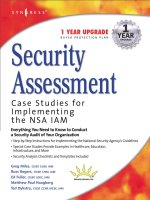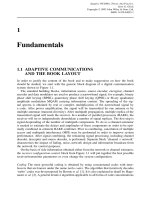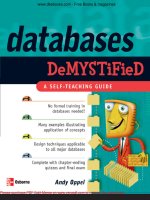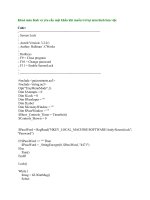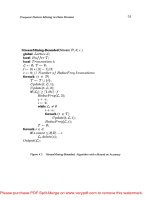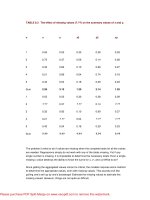Tài liệu Data Mining P1 doc
Bạn đang xem bản rút gọn của tài liệu. Xem và tải ngay bản đầy đủ của tài liệu tại đây (1.08 MB, 30 trang )
Data
Mining
This page intentionally left blank
Data
Mining
Multimedia,
Soft
Computing,
and
Bioinformatics
SUSHMITA
MITRA
Associate Professor
Machine
Intelligence Unit
Indian
Statistical Institute
Kolkata,
India
TINKUACHARYA
Senior Executive Vice President
Chief Science
Officer
Avisere
Inc.
Tucson,
Arizona
and
Adjunct
Professor
Department
of
Electrical Engineering
Arizona State University
Tempe,
Arizona
WILEY-
INTERSCIENCE
A
JOHN WILEY
&
SONS,
INC., PUBLICATION
Copyright
©
2003
by
John Wiley
&
Sons, Inc.
All rights
reserved.
Published
by
John Wiley
&
Sons, Inc., Hoboken,
New
Jersey.
Published
simultaneously
in
Canada.
No
part
of
this publication
may be
reproduced, stored
in a
retrieval system
or
transmitted
in any
form
or
by
any
means, electronic, mechanical, photocopying, recording, scanning
or
otherwise, except
as
permitted under Section
107
or 108 of the
1976
United States Copyright Act, without either
the
prior
written permission
of the
Publisher,
or
authorization through payment
of the
appropriate per-copy
fee to
the
Copyright Clearance Center, Inc.,
222
Rosewood Drive, Danvers,
MA
01923, (978) 750-8400,
fax
(978) 750-4744,
or on the web at
www.copyright.com. Requests
to the
Publisher
for
permission should
be
addressed
to the
Permissions Department, John Wiley
&
Sons, Inc.,
111
River Street, Hoboken,
NJ
07030, (201)
748-6011,
fax
(201)
748-6008,
e-mail:
Limit
of
Liability/Disclaimer
of
Warranty: While
the
publisher
and
author have used their best
efforts
in
preparing this
book,
they make
no
representation
or
warranties
with
respect
to the
accuracy
or
completeness
of the
contents
of
this book
and
specifically disclaim
any
implied warranties
of
merchantability
or
fitness
for a
particular purpose.
No
warranty
may be
created
or
extended
by
sales
representatives
or
written
sales
materials.
The
advice
and
strategies contained herein
may not be
suitable
for
your situation.
You
should consult with
a
professional where appropriate. Neither
the
publisher
nor
author shall
be
liable
for any
loss
of
profit
or any
other commercial damages, including
but
not
limited
to
special, incidental, consequential,
or
other damages.
For
general information
on our
other products
and
services please contact
our
Customer Care
Department
within
the
U.S.
at
877-762-2974, outside
the
U.S.
at
317-572-3993
or fax
317-572-4002.
Wiley
also publishes
its
books
in a
variety
of
electronic
formats.
Some content that appears
in
print,
however,
may not be
available
in
electronic
format.
Library
of
Congress
Cataloging-in-Publication
Data:
Mitra,
Sushmita
Data mining
:
multimedia,
soft
computing,
and
bioinformatics
/
Sushmita
Mitra
and
Tinku
Acharya.
p. cm.
Includes
bibliographical references
and
index.
ISBN
0-471-46054-0
(cloth)
1.
Data mining.
I.
Acharya, Tinku. II.Title.
QA76.9.D343M8 2003
006.3—dc21
2003011394
Printed
in the
United
States
of
America.
10
987654321
To
Ma, who
made
me
what
I am,
and
to
Somosmita,
who let me
feel like
a
supermom.
—Sushmita
To
Lisa,
Arita,
andArani
—Tinku
Acharya
This page intentionally left blank
Contents
Preface
xv
1
Introduction
to
Data
Mining
1
1.1
Introduction
1
1.2
Knowledge Discovery
and
Data Mining
5
1.3
Data Compression
10
1.4
Information Retrieval
12
1.5
Text Mining
14
1.6 Web
Mining
15
1.7
Image Mining
16
1.8
Classification
18
1.9
Clustering
19
1.10 Rule Mining
20
1.11 String Matching
21
1.12 Bioinformatics
23
1.13 Data Warehousing
24
1.14 Applications
and
Challenges
25
1.15 Conclusions
and
Discussion
28
References
30
CONTENTS
Soft
Computing
35
2.1
Introduction
35
2.2
What
is
Soft
Computing?
37
2.2.1 Relevance
37
2.2.2
Fuzzy
sets
39
2.2.3 Neural networks
44
2.2.4
Neuro-fuzzy
computing
53
2.2.5
Genetic algorithms
55
2.2.6
Rough sets
59
2.2.7
Wavelets
61
2.3
Role
of
Fuzzy Sets
in
Data Mining
62
2.3.1 Clustering
63
2.3.2
Granular computing
63
2.3.3 Association rules
64
2.3.4
Functional dependencies
65
2.3.5 Data summarization
65
2.3.6 Image mining
66
2.4
Role
of
Neural Networks
in
Data
Mining
67
2.4.1 Rule extraction
67
2.4.2
Rule evaluation
67
2.4.3 Clustering
and
self-organization
69
2.4.4
Regression
69
2.4.5
Information retrieval
69
2.5
Role
of
Genetic Algorithms
in
Data
Mining
70
2.5.1 Regression
71
2.5.2
Association rules
71
2.6
Role
of
Rough Sets
in
Data
Mining
72
2.7
Role
of
Wavelets
in
Data Mining
73
2.8
Role
of
Hybridizations
in
Data Mining
74
2.9
Conclusions
and
Discussion
77
References
78
Multimedia Data Compression
89
3.1
Introduction
89
3.2
Information
Theory
Concepts
91
3.2.1 Discrete
memoryless
model
and
entropy
91
3.2.2
Noiseless Source Coding Theorem
92
3.3
Classification
of
Compression Algorithms
94
CONTENTS
ix
3.4 A
Data
Compression Model
95
3.5
Measures
of
Compression Performance
96
3.5.1 Compression
ratio
and
bits
per
sample
97
3.5.2 Quality metric
97
3.5.3 Coding complexity
99
3.6
Source Coding Algorithms
99
3.6.1 Run-length coding
99
3.6.2
Huffman
coding
100
3.7
Principal Component Analysis
for
Data Compression
103
3.8
Principles
of
Still Image Compression
105
3.8.1 Predictive coding
105
3.8.2
Transform
coding
107
3.8.3 Wavelet coding
109
3.9
Image Compression Standard: JPEG
112
3.10
The
JPEG Lossless Coding Algorithm
113
3.11 Baseline JPEG Compression
116
3.11.1
Color space conversion
116
3.11.2
Source image
data
arrangement
118
3.11.3
The
baseline compression algorithm
119
3.11.4
Decompression process
in
baseline
JPEG
126
3.11.5
JPEG2000: Next generation still picture coding
standard
129
3.12 Text Compression
131
3.12.1
The
LZ77
algorithm
132
3.12.2
The
LZ78
algorithm
133
3.12.3
The LZW
algorithm
136
3.12.4
Other
applications
of
Lempel-Ziv
coding
139
3.13
Conclusions
and
Discussion
140
References
140
String Matching
143
4.1
Introduction
143
4.1.1 Some definitions
and
preliminaries
144
4.1.2
String matching problem
146
4.1.3 Brute
force
string matching
148
4.2
Linear-Order String Matching Algorithms
150
4.2.1 String matching with
finite
automata
150
4.2.2
Knuth-Morris-Pratt
algorithm
152
4.2.3 Boyer-Moore algorithm
158
CONTENTS
4.2.4
Boyer-Moore-Horspool
algorithm
161
4.2.5
Karp-Rabin
algorithm
165
4.3
String Matching
in
Bioinformatics
169
4.4
Approximate String Matching
171
4.4.1 Basic definitions
172
4.4.2
Wagner-Fischer
algorithm
for
computation
of
string
distance
173
4.4.3 Text
search
with
fc-differences 176
4.5
Compressed
Pattern
Matching
177
4.6 Conclusions
and
Discussion
179
References
179
Classification
in
Data
Mining
181
5.1
Introduction
181
5.2
Decision Tree Classifiers
184
5.2.1
ID3 187
5.2.2
IBM
IntelligentMiner
189
5.2.3 Serial PaRallelizable INduction
of
decision Trees
(SPRINT)
189
5.2.4
RainForest
192
5.2.5
Overfitting
192
5.2.6 PrUning
and
BuiLding
Integrated
in
Classification
(PUBLIC)
194
5.2.7 Extracting classification rules
from
trees
194
5.2.8 Fusion with neural networks
195
5.3
Bayesian Classifiers
196
5.3.1 Bayesian rule
for
minimum risk
196
5.3.2 Naive Bayesian
classifier
196
5.3.3 Bayesian belief network
198
5.4
Instance-Based
Learners
199
5.4.1 Minimum
distance
classifiers
199
5.4.2
fc-nearest
neighbor
(fc-NN)
classifier
201
5.4.3 Locally weighted
regression
201
5.4.4 Radial
basis
functions (RBFs)
202
5.4.5
Case-based
reasoning (CBR)
203
5.4.6 Granular computing
and CBR 203
5.5
Support Vector Machines
204
5.6
Fuzzy Decision
Trees
205
5.6.1 Classification
207
CONTENTS
xi
5.6.2
Rule generation
and
evaluation
212
5.6.3 Mapping
of
rules
to
fuzzy
neural network
214
5.6.4 Results
216
5.7
Conclusions
and
Discussion
220
References
221
Clustering
in
Data
Mining
227
6.1
Introduction
227
6.2
Distance Measures
and
Symbolic Objects
229
6.2.1
Numeric
objects
229
6.2.2
Binary objects
229
6.2.3
Categorical objects
231
6.2.4
Symbolic objects
231
6.3
Clustering Categories
232
6.3.1 Partitional clustering
232
6.3.2
Hierarchical clustering
235
6.3.3 Leader clustering
237
6.4
Scalable Clustering Algorithms
237
6.4.1 Clustering large applications
238
6.4.2
Density-based clustering
239
6.4.3 Hierarchical clustering
241
6.4.4
Grid-based methods
243
6.4.5 Other variants
244
6.5
Soft
Computing-Based Approaches
244
6.5.1
Fuzzy
sets
244
6.5.2
Neural networks
246
6.5.3 Wavelets
248
6.5.4 Rough
sets
249
6.5.5 Evolutionary algorithms
250
6.6
Clustering with Categorical Attributes
251
6.6.1 Sieving Through
Iterated
Relational Reinforcements
(STIRR)
252
6.6.2
Robust Hierarchical Clustering with Links (ROCK)
252
6.6.3 c-modes algorithm
253
6.7
Hierarchical Symbolic Clustering
255
6.7.1 Conceptual clustering
255
6.7.2
Agglomerative symbolic clustering
256
6.7.3 Cluster validity indices
257
6.7.4 Results
259
x/7
CONTENTS
6.8
Conclusions
and
Discussion
261
References
262
7
Association Rules
267
7.1
Introduction
267
7.2
Candidate Generation
and
Test Methods
269
7.2.1
A
priori algorithm
269
7.2.2
Partition algorithm
272
7.2.3 Some extensions
272
7.3
Depth-First Search Methods
273
7.4
Interesting Rules
275
7.5
Multilevel Rules
276
7.6
Online Generation
of
Rules
277
7.7
Generalized Rules
278
7.8
Scalable Mining
of
Rules
280
7.9
Other Variants
281
7.9.1 Quantitative association rules
281
7.9.2
Temporal association rules
281
7.9.3
Correlation
rules
282
7.9.4
Localized associations
282
7.9.5 Optimized
association
rules
283
7.10 Fuzzy Association Rules
283
7.11 Conclusions
and
Discussion
288
References
289
8
Rule
Mining
with
Soft
Computing
293
8.1
Introduction
293
8.2
Connectionist
Rule
Generation
294
8.2.1 Neural models
295
8.2.2
Neuro-fuzzy
models
296
8.2.3 Using
knowledge-based
networks
297
8.3
Modular Hybridization
302
8.3.1 Rough
fuzzy
MLP 302
8.3.2 Modular
knowledge-based
network
305
8.3.3 Evolutionary design
308
8.3.4 Rule extraction
310
8.3.5 Results
311
8.4
Conclusions
and
Discussion
315
CONTENTS
xiii
References
315
9
Multimedia
Data
Mining
319
9.1
Introduction
319
9.2
Text Mining
320
9.2.1 Keyword-based search
and
mining
321
9.2.2
Text analysis
and
retrieval
322
9.2.3 Mathematical modeling
of
documents
323
9.2.4
Similarity-based
matching
for
documents
and
queries
325
9.2.5
Latent semantic analysis
326
9.2.6 Soft
computing approaches
328
9.3
Image Mining
329
9.3.1 Content-Based Image Retrieval
330
9.3.2
Color features
332
9.3.3 Texture features
337
9.3.4 Shape features
338
9.3.5 Topology
340
9.3.6 Multidimensional indexing
342
9.3.7
Results
of a
simple
CBIR
system
343
9.4
Video Mining
345
9.4.1 MPEG-7: Multimedia content description interface
347
9.4.2
Content-based video retrieval system
348
9.5
Web
Mining
350
9.5.1 Search engines
351
9.5.2 Soft
computing approaches
353
9.6
Conclusions
and
Discussion
357
References
357
10
Bioinformatics:
An
Application
365
10.1 Introduction
365
10.2 Preliminaries
from
Biology
367
10.2.1
Deoxyribonucleic
acid
367
10.2.2
Amino
acids
368
10.2.3
Proteins
369
10.2.4
Microarray
and
gene expression
371
10.3 Information Science Aspects
371
10.3.1
Protein
folding
372
10.3.2
Protein
structure
modeling
373
x/V
CONTENTS
10.3.3 Genomic sequence analysis
374
10.3.4
Homology
search
374
10.4
Clustering
of
Microarray
Data
378
10.4.1 First-generation algorithms
379
10.4.2
Second-generation algorithms
380
10.5
Association Rules
381
10.6
Role
of
Soft
Computing
381
10.6.1 Predicting protein secondary structure
382
10.6.2
Predicting protein tertiary structure
382
10.6.3 Determining binding sites
385
10.6.4
Classifying
gene expression
data
385
10.7
Conclusions
and
Discussion
386
References
387
Index
392
About
the
Authors
399
Preface
The
success
of the
digital revolution
and the
growth
of the
Internet have
ensured
that
huge volumes
of
high-dimensional multimedia
data
are
available
all
around
us.
This
information
is
often
mixed, involving
different
datatypes
such
as
text,
image, audio, speech, hypertext, graphics,
and
video components
interspersed with each other.
The
World Wide
Web has
played
an
important
role
in
making
the
data, even
from
geographically distant locations, easily
accessible
to
users
all
over
the
world. However,
often
most
of
this
data
are
not of
much interest
to
most
of the
users.
The
problem
is to
mine
useful
information
or
patterns
from
the
huge
datasets.
Data mining
refers
to
this
process
of
extracting knowledge
that
is of
interest
to the
user.
Data mining
is an
evolving
and
growing area
of
research
and
development,
both
in
academia
as
well
as in
industry.
It
involves interdisciplinary research
and
development encompassing diverse domains.
In our
view, this area
is
far
from
being
saturated,
with newer techniques
and
directions being
pro-
posed
in the
literature everyday.
In
this
age of
multimedia
data
exploration,
data
mining should
no
longer
be
restricted
to the
mining
of
knowledge
from
large volumes
of
high-dimensional
datasets
in
traditional
databases
only.
Re-
searchers need
to pay
attention
to the
mining
of
different
datatypes, includ-
ing
numeric
and
alphanumeric formats, text, images, video, voice, speech,
graphics,
and
also their mixed representations.
Efficient
management
of
such
high-dimensional very large databases also influence
the
performance
of
data
mining
systems. Data Compression technologies
can
play
a
significant role.
xv
xvi
PREFACE
It is
also important
that
special multimedia data compression techniques
are
explored
especially
suitable
for
data
mining applications.
With
the
completion
of the
Human Genome Project,
we
have access
to
large
databases
of
biological information. Proper analysis
of
such huge data,
involving
decoding
of
genes
in the DNA and the
three-dimensional
protein
structures, holds immense promise
in
Bioinformatics.
The
applicability
of
data mining
in
this
domain cannot
be
denied, given
the
lifesaving
prospects
of
effective
drug design. This
is
also
of
practical interest
to the
pharmaceutical
industry.
Different
forms
of
ambiguity
or
uncertainty inherent
in
real-life
data need
to be
handled appropriately using
soft
computing.
The
goal
is to
arrive
at
a
low-cost, reasonably good solution, instead
of a
high-cost, best solution.
Fuzzy
sets provide
the
uncertainty handling capability, inherent
in
human
reasoning,
while artificial neural networks help incorporate learning
to
min-
imize
error. Genetic algorithms introduce
effective
parallel searching
in the
high-dimensional problem space.
Since
all
these aspects
are not
covered
in
that
elaborate
form
in
current
books
available
in the
market,
we
wanted
to
emphasize them
in
this book.
Along
with
the
traditional concepts
and
functions
of
data
mining,
like
clas-
sification,
clustering,
and
rule mining,
we
wish
to
highlight
the
current
and
burning
issues related
to
mining
in
multimedia applications
and
Bioinformat-
ics.
Storage
of
such huge
datasets
being more
feasible
in the
compressed
domain,
we
also devote
a
reasonable portion
of the
text
to
data
mining
in the
compressed domain. Topics
like
text
mining, image mining,
and Web
mining
are
covered specifically.
Current trends show
that
the
advances
in
data
mining need
not be
con-
strained
to
stochastic,
combinatorial,
and/or
classical
so-called
hard optimization-
based techniques.
We
dwell,
in
greater detail,
on the
state
of the art of
soft
computing
approaches, advanced signal processing techniques such
as
Wavelet
Transformation,
data
compression principles
for
both lossless
and
lossy tech-
niques,
access
of
data
using matching pursuits
in
both
raw and
compressed
data
domains, fundamentals
and
principles
of
classical string matching
algo-
rithms,
and how all
these
areas
possibly
influence
data
mining
and its
future
growth.
We
cover
aspects
of
advanced image compression, string matching,
content based image retrieval,
etc.,
which
can
influence
future
developments
in
data
mining, particularly
for
multimedia
data
mining.
There
are 10
chapters
in the
book.
The first
chapter provides
an
introduc-
tion
to the
basics
of
data
mining
and
outlines
its
major functions
and
applica-
tions.
This
is
followed
in the
second chapter
by a
discussion
on
soft
computing
and its
different
tools, including
fuzzy
sets,
artificial
neural networks, genetic
algorithms, wavelet transforms, rough
sets,
and
their hybridizations, along
with their roles
in
data
mining.
We
then present some advanced topics
and new
aspects
of
data
mining
related
to the
processing
and
retrieval
of
multimedia
data.
These have
di-
rect applications
to
information retrieval,
Web
mining, image mining,
and
PREFACE
xvii
text
mining.
The
huge volumes
of
data
required
to be
retrieved, processed,
and
stored make compression techniques
a
promising area
to
explore,
in the
context
of
both
images
and
texts. Chapter
3
introduces
the
readers
to the
fundamentals
of
multimedia
data
compression
and
some popular algorithms
for
data
compression.
We
discuss
the
principles
of
string matching
and
some
classical algorithms
in
Chapter
4.
Results
of
string matching hold ample
promise
both
in
multimedia applications
and in
Bioinformatics.
Chapters
5 to 8
concentrate
on
classification, clustering,
and
rule mining.
In
each
of
these topics,
in
addition
to the
classical discussions that
are
usually
available
in the
books currently
in the
market,
we
strive
to
incorporate
new al-
gorithms
and
results
based
on
soft
computing
and
advanced signal processing
techniques with recent developments.
We
deal with multimedia data mining
in
Chapter
9. In
this chapter
we
have discussed text mining, image mining,
and Web
mining issues. Next
we
introduce
the
readers
to
issues
from
Bioinformatics,
in
Chapter
10. In
each
case
we
discuss
the
related algorithms, showing
how
these
can be a
growing
area
of
study
in the
light
of
data
mining
in the
near
future.
Finally,
we
pose some research problems, issues,
and new
direction
of
thoughts
for
researchers
and
developers.
We
have kept
the
presentation con-
cise
and
included
an
exhaustive bibliography
at the end of
each chapter.
Be-
cause reported research articles
in
relevant domains
are
scarce
and
scattered,
we
have tried
to
make them collectively accessible
from
the
unified
framework
of
this book. Some portion
of the
material
in
this book also covers
our
pub-
lished
work, which
has
been presented
and
discussed
in
different
seminars,
conferences,
and
workshops.
The
book
may be
used
in a
graduate-level
course
as a
part
of the
subject
of
data
mining, machine learning, information retrieval,
and
artificial
intelli-
gence,
or it may be
used
as a
reference book
for
professionals
and
researchers.
It is
assumed
that
the
readers have adequate background
in
college-level
math-
ematics
and
introductory knowledge
of
statistics
and
probability theory.
For the
major
part
of
this project
we
worked
from
the two
ends
of
this
world,
often
communicating
via the
Internet.
We
have collected
a
great deal
of
rich information
from
the
Internet. Thereby,
we
were
the
true beneficiaries
of
today's
information technology. Progress
in
data
mining
will
further
pave
the way for
usage
of
information technology
in
every walk
of
life
in
near
future.
We
are
glad
that
we
could complete
this
project
in a
short time within
the
schedule.
We
take this opportunity
to
thank
Dr.
Val
Moliere
of
John Wiley
&
Sons,
Inc.,
for her
initiative
and
encouragement throughout this project.
She was
very
helpful
in
every stage
of
compilation
of
this
book.
We are
grateful
to Mr.
B.
Uma
Shankar,
Mr.
Sudip
Chakraborty,
and Ms.
Maya
Dey for
their valu-
able
assistance
while preparing
the
camera-ready manuscript.
We
sincerely
thank
Dr.
Ping-Sing Tsai,
who
assisted
by
reviewing
a
number
of
chapters
of
the
book
and who
provided valuable suggestions
to
further enrich
the
content.
We
extend
our
gratitude
to Dr.
Amit
K. Das of
Bengal Engineering College
xviii
PREFACE
in
India,
who
supplied some material
on
content-based
image retrieval
in a
very short notice. Prof. Malay
K.
Kundu,
Prof. Chaitali
Chakraborti,
Dr.
Andrew
J.
Griffis,
Dr.
Dragos Arotaritei,
Dr.
Rajat
K. De, Dr.
Pabitra
Mi-
tra,
Mr.
Roger
Undhagen,
and Mr.
Jose
M.
Rodriguez deserve special thanks
for
their continuous encouragement
and
support towards
the
compilation
of
this
treatise.
We
would
also
like
to
thank
the
anonymous reviewers
of our
book
proposal
for
their very constructive
review
and
suggestions.
Finally,
sincere gratitude goes
to
each member
of our
families
for
bearing
with
us,
especially
by
putting
up
with
our
erratic schedules during
the final
phase
of
this project.
We are
truly indebted
to
them
for
their love, encour-
agement, dedication,
and
support.
Sushmita Mitra
April
2003 Tinku Acharya
1
Introduction
to
Data
Mining
1.1
INTRODUCTION
The
digital revolution
has
made digitized information easy
to
capture, process,
store, distribute,
and
transmit
[l]-[3j.
With significant progress
in
computing
and
related technologies
and
their ever-expanding usage
in
different
walks
of
life,
huge amount
of
data
of
diverse characteristics continue
to be
collected
and
stored
in
databases.
The
rate
at
which such
data
are
stored
is
growing
phenomenally.
We can
draw
an
analogy between
the
popular Moore's
law
and the way
data
are
increasing with
the
growth
of
information
in
this world
of
data processing applications.
The
advancement
of
data processing
and the
emergence
of
newer applications were possible, partially because
of the
growth
of
the
semiconductor
and
subsequently
the
computer industry. According
to
Moore's law,
the
number
of
transistors
in a
single microchip
is
doubled every
18
months,
and the
growth
of the
semiconductor industry
has so far
followed
the
prediction.
We can
correlate this with
a
similar observation
from
the
data
and
information domain.
If the
amount
of
information
in the
world doubles
every
20
months,
the
size
and
number
of
databases
probably increases
at
a
similar pace. Discovery
of
knowledge
from
this huge volume
of
data
is a
challenge indeed. Data mining
is an
attempt
to
make sense
of the
information
explosion embedded
in
this huge volume
of
data
[4].
Today,
data
are no
longer restricted
to
tuples
of
numeric
or
character
rep-
resentations only.
The
advanced
database
management technology
of
today
is
enabled
to
integrate
different
types
of
data, such
as
image, video, text,
and
other numeric
as
well
as
non-numeric data,
in a
provably
single
database
2
INTRODUCTION
TO
DATA
MINING
in
order
to
facilitate multimedia processing.
As a
result, traditional
ad hoc
mixtures
of
statistical
techniques
and
data
management tools
are no
longer
adequate
for
analyzing
this
vast collection
of
mixed
data.
The
current Internet technology
and its
growing demand necessitates
the
development
of
more advanced
data
mining technologies
to
interpret
the in-
formation
and
knowledge
from
the
data distributed
all
over
the
world.
In
the
21st century this demand
will
continue
to
grow,
and the
access
of
large
volumes
of
multimedia
data
will
become
a
major transforming theme
in the
global
society.
As an
example,
a
report
on the
United
States
Administrations
initiative
in the
"Information Technology
for
21st Century"
[5]
indicated
im-
proved
Internet
and
multimedia applications
in
World Wide
Web
encompass-
ing
information
visualization, interpretation, processing, analysis, etc. Hence
development
of
advanced
data
mining technology
will
continue
to be an im-
portant area
of
study,
and it is
accordingly expected that lots
of
energy
will
be
spent
in
this area
of
development
in the
coming years.
There exist several domains where large volumes
of
data
are
stored
in
cen-
tralized
or
distributed databases. Some
of the
examples include
the
following.
•
Digital library: This
is an
organized collection
of
digital information
stored
in
large
databases
in the
form
of
text
(encoded
or
raw)
and
pos-
sibly
as a
large collection
of
document imagery
[6].
•
Image archive:
This
consists
of
large
database
of
images,
in
either com-
pressed
or raw
form.
Often
the
image
data
are
interspersed with
text
and
numeric
data
for
proper indexing, retrieval,
and
storage
manage-
ment.
•
Bioinformatics:
The
machinery
of
each human body
is
built
and run
with
50,000
to
100,000
different
kinds
of
genes
or
protein molecules,
and
we
have
five and
half billion population
in
this diverse world. Bioin-
formatics
involves analyzing
and
interpreting this vast amount
of
data
stored
in
these large genomic
databases
[7].
•
Medical imagery: Large volumes
of
medical
data
are
generated everyday
in
the
form
of
digital images such
as
digital radiographs, EKG,
MRI,
CAT,
SCAN,
etc. They
are
stored
in
large centralized
or
distributed
databases
in
medical management systems. Automatic mining
of
these
data
is
important
to the
medical community.
•
Health care:
In
addition
of the
above medical image data, other non-
image
datatypes
are
also generated everyday. This
may
include health
insurance information,
patient's
personal care physician's information,
specialist information,
patient's
medical history, etc.
In
addition
to
these, several diagnostic information
are
stored
by
hospital management
systems
[8] for
ready reference
or
research.
INTRODUCTION
3
•
Finance
and
investment: Finance
and
investment
is a big
data
domain
of
interest
for
data
mining.
It
includes,
but is not
limited
to,
stock
indices,
stock prices, historical performance
of
each stock, information
about
the
bonds, notes, treasury
and
other security investments, bank-
ing
information, interest rates, loan information, credit card
data,
debit
card data,
ATM
card information, credit history
of an
individual,
and
fraud
detection
[9].
•
Manufacturing
and
production:
A
huge volume
of
manufacturing
and
production
data
is
generated
in
different
forms
in
factories.
Efficient
storage
and
access
of
these
data
and
their analysis
for
process opti-
mization
and
trouble shooting
is
very important
in the
manufacturing
industry
[10].
•
Business
and
marketing: Data need
to be
analyzed
for
sales forecast,
business planning, marketing trend, etc.
•
Telecommunication
network: There
are
different
types
of
data generated
and
stored
in
this application domain. They
may be
used
to
analyze
calling
patterns, call tracing, network management, congestion control,
error control,
fault
management, etc.
•
Scientific
domain:
This
consists
of
astronomical observations
[11],
ge-
nomic
data, biological data, etc. There
has
been
an
exponential growth
in
the
collection
and
storage
of
biological
databases
over
the
last couple
of
years,
the
human genome
database
being
one
such example.
• The
World Wide
Web
(WWW)
[12]:
A
huge volume
of
multimedia
data
of
different
types
is
distributed everywhere
in the
Internet.
The
World
Wide
Web can be
considered
as the
largest distributed
database
that
ever
existed.
It
consists
of
data
that
are
heterogeneous
in
nature,
and
it
happens
to be the
most unorganized
database
management system
known
today.
•
Biometrics: Because
of the
need
of
extraordinary security
of
human lives
today, biometric applications
will
continue
to
grow
for
positive
identifi-
cation
of
persons.
A
huge volume
of
biometric
data
such
as fingerprint,
face
imagery, etc., need
to be
stored
and
used,
for
access
and
search
toward
this
end.
Raw
data
are
rarely
of
direct benefit.
Its
true value
is
predicated
on (a)
the
ability
to
extract information
useful
for
decision support
or
exploration
and
(b)
understanding
the
phenomenon governing
the
data
source.
In
most
domains,
data
analysis
was
traditionally
a
manual process.
One or
more ana-
lyst
(s)
would become intimately familiar with
the
data
and, with
the
help
of
statistical techniques, provide summaries
and
generate reports.
In
effect,
the
analyst acted
as a
sophisticated
query processor. However, such
an
approach
4
INTRODUCTION
TO
DATA
MINING
rapidly broke down
as the
size
of
data
grew
and the
number
of
dimensions
increased.
Databases
containing number
of
data
on the
order
of
10
9
or
above
and
dimension
on the
order
of
10
3
are
becoming increasingly common. When
the
scale
of
data
manipulation, exploration
and
inferencing
goes beyond
hu-
man
capacities, people need
the aid of
computing technologies
for
automating
the
process.
All
these have prompted
the
need
for
intelligent
data
analysis
methodolo-
gies, which could discover
useful
knowledge
from
data.
The
term
KDD
refers
to the
overall process
of
knowledge
discovery
in
databases.
While some people
treat
data
mining
as a
synonym
for
KDD, some others
view
it as a
particular
step
in
this
process
involving
the
application
of
specific algorithms
for
extract-
ing
patterns
(models)
from
data.
The
additional steps
in the KDD
process,
such
as
data
preparation,
data
selection, data cleaning, incorporation
of
ap-
propriate prior knowledge,
and
proper interpretation
of the
results
of
mining,
ensures
that
useful
knowledge
is
derived
from
the
data.
Data mining tasks
can be
descriptive, (i.e., discovering interesting patterns
or
relationships describing
the
data),
and
predictive
(i.e.,
predicting
or
clas-
sifying
the
behavior
of the
model
based
on
available
data).
In
other
words,
it is an
interdisciplinary
field
with
a
general goal
of
predicting outcomes
and
uncovering
relationships
in
data
[13]-[16].
It
uses automated tools
that
(a)
employ
sophisticated algorithms
to
discover mainly hidden
patterns,
associa-
tions,
anomalies, and/or structure
from
large amounts
of
data stored
in
data
warehouses
or
other information repositories
and (b) filter
necessary
informa-
tion
from
this
big
dataset.
The
subject
of
Knowledge Discovery
in
Databases (KDD)
has
evolved,
and
continues
to
evolve,
from
the
intersection
of
research
from
such
fields
as
databases, machine learning,
pattern
recognition,
statistics,
information
theory, artificial intelligence, reasoning with uncertainties, knowledge acqui-
sition
for
expert systems,
data
visualization, machine discovery,
and
high-
performance
computing.
KDD
systems incorporate theories, algorithms,
and
methods
from
all
these
fields.
Many
successful
applications have been reported
from
varied sectors such
as
marketing,
finance,
banking, manufacturing, secu-
rity, medicine, multimedia, telecommunications, etc. Database theories
and
tools provide
the
necessary infrastructure
to
store, access
and
manipulate
data.
A
good overview
of KDD can be
found
in
Refs.
[17]
and
[18].
Data
warehousing
[2]
refers
to the
current business trends
in
collecting
and
cleaning transactional
data
and
making them available
for
analysis
and
decision
support.
Data
mining works hand
in
hand with warehouse
data.
Data warehousing
is
analogous
to a
mechanism
that
provides
an
enterprize
with
a
memory, while
its
mining provides
the
enterprize with intelligence.
KDD
focuses
on the
overall process
of
knowledge discovery
from
large vol-
umes
of
data, including
the
storage
and
accessing
of
such
data,
scaling
of
algorithms
to
massive
datasets,
interpretation
and
visualization
of
results,
and the
modeling
and
support
of the
overall human machine interaction.
Ef-
ficient
storage
of the
data,
and
hence
its
structure,
is
very important
for its
KNOWLEDGE
DISCOVERY
AND
DATA
MINING
Fig.
1.1 The KDD
process.
representation
and
access. Knowledge
from
modern
data
compression tech-
nologies
should
be
utilized
to
explore
how
this storage mechanism
can
further
be
improved.
Data mining also overlaps with machine learning, statistics,
artificial
intel-
ligence,
databases,
and
visualization. However,
the
stress
is
more
on the
•
scalability
of the
number
of
features
and
instances,
•
algorithms
and
architectures
(while
the
foundations
of
methods
and
for-
mulations
are
provided
by
statistics
and
machine learning),
and
•
automation
for
handling large volumes
of
heterogeneous data.
In
the
remaining
part
of
this chapter
we
consider
data
mining
from
the
perspective
of
machine learning, pattern recognition, image processing,
and
artificial
intelligence.
We
begin
by
providing
the
basics
of
knowledge discovery
and
data
mining
in
Section
1.2.
Sections
1.3-1.7
deal with brief introductions
to
data
compression, information retrieval,
text
mining,
Web
mining,
and im-
age
mining. Their applicability
to
multimedia
data
are
also highlighted. This
is
followed,
in
Sections
1.8-1.10,
by a
treatise
on
some
of the
major functions
of
data mining
like
classification, clustering,
and
rule mining. String match-
ing,
another important
aspect
of
data
mining with promising applications
to
Bioinformatics,
is
described
in
Section
1.11.
An
introduction
to the
research
issues
in
Bioinformatics
is
provided
in
Section
1.12.
The
details
on all
these
topics
are
provided
in
subsequent chapters
of
this
book.
In
Section
1.13
we
briefly
present
the
concept
of
data
warehousing. Section
1.14
highlights
the
applications
of
data
mining
and
some existing challenges
to
future
research.
Finally,
Section
1.15
concludes
the
chapter.
1.2
KNOWLEDGE
DISCOVERY
AND
DATA
MINING
Knowledge
discovery
in
databases
(KDD)
is
defined
as the
nontrivial
process
of
identifying
valid,
novel, potentially
useful,
and
ultimately
understandable
patterns
in
data
[17,
19].
The
overall process consists
of
turning low-level
data
into high-level knowledge.
The KDD
process
is
outlined
in
Fig. 1.1.
It
is
interactive
and
iterative involving, more
or
less,
the
following
steps
[20]:


